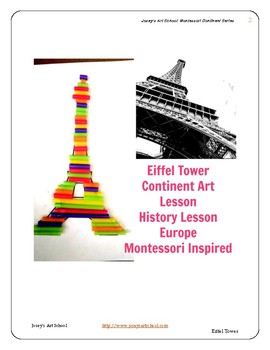Eiffel Tower Art Project Montessori Grade Pre-K to 2nd Grade
- PDF
Description
The Eiffel Tower is a world-famous monument located in Paris, France. It was built in 1889 as the entrance arch to the World's Fair, and it has become an iconic symbol of the city of Paris and French culture.
In this art lesson, students will have the opportunity to create their own version of the Eiffel Tower out of straws. They will learn about the history and significance of the monument, as well as develop their fine motor skills and creativity.
Here are four ways to integrate this art lesson into other subjects in the elementary school classroom:
- Social Studies: Use the Eiffel Tower as a starting point to explore French history and culture. Students can research French landmarks, traditions, and cuisine, and present their findings to the class.
- Math: Challenge students to use their knowledge of geometry to create a to-scale version of the Eiffel Tower. They can calculate the measurements of each section of the tower, and work collaboratively to ensure that the final product is proportional and accurate.
- Language Arts: Have students write a descriptive paragraph or poem about the Eiffel Tower. Encourage them to use sensory details to bring the monument to life, and incorporate vocabulary related to architecture and engineering.
- Science: Discuss the physics behind the construction of the Eiffel Tower. Students can learn about the properties of materials used to build the tower, and explore concepts such as gravity, weight, and balance. They can also experiment with building their own structures out of different materials to test their strength and stability.
Overall, this art lesson is a fun and engaging way to explore the history and significance of the Eiffel Tower, while also integrating other subjects into the curriculum. By creating their own versions of the tower, students will develop their creativity, critical thinking, and teamwork skills.
THIS LESSON COMPLIES WITH MANY ELA COMMON CORE STANDARDS
Continent: Europe
Country: France
Art Project: Eiffel Tower
-Copy of the real life paintings
-Discussion about the topic and real life pictures to engage with the students in deeper conversation
-questions to ask your students to engage the pictures
-FULL COLOR AND THOROUGH step by step instructions
CLICK HERE to view my freebies
CLICK HERE to view my DRAWING LESSONS
CLICK HERE to view my ART WITH THE MASTERS ART LESSONS
CLICK HERE to view my CONTEMPORARY ART LESSONS
CLICK HERE to view my ART LESSONS THAT COMPLIMENT POPULAR BOOKS
CLICK HERE to view my SELF ESTEEM PROJECTS
CLICK HERE to view my CLASS MURAL IDEAS
CLICK HERE to view my FUN ART FOLK ART LESSONS
CLICK HERE to view my 3 BUNDLED LESSONS
CLICK HERE to view my 5 BUNDLED LESSONS
Make sure to click the GREEN STAR near my store name so that you can stay in touch with my store. I create new lessons every week.





